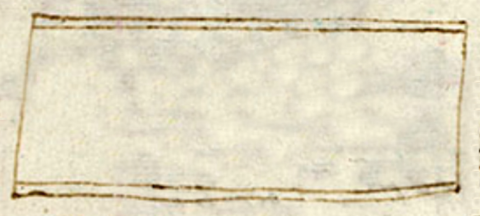terciopelo (CST44)
This black and white line drawing of the simplex glyph for the term terciopelo (velvet) shows a large horizontal, rectangular piece of cloth with a single line for a border on the top and lower edges. The cloth is not colored here, but the companion text says this image represents twelve varas (about twelve yards) of red (chichiltic) velvet for the church. Dalmatics were to be made from this fabric.
Stephanie Wood
For more on the Codex Sierra, see Kevin Terraciano’s study (2021).
Stephanie Wood
1550–1564
Jeff Haskett-Wood
textiles, telas, chichiltic, varas, iglesias, religión

terciopelo (a loanword from Spanish, taken into Nahuatl), velvet, https://nahuatl.wired-humanities.org/content/terciopelo
terciopelo
Stephanie Wood
Códice Sierra-Texupan, plate 44, page dated 1561. Origin: Santa Catalina Texupan, Mixteca Alta, State of Oaxaca. Kevin Terraciano has published an outstanding study of this manuscript (Codex Sierra, 2021), and in his book he refers to alphabetic and “pictorial” writing, not hieroglyphic writing. We are still counting some of the imagery from this source as hieroglyphic writing, but we are also including examples of “iconography” where the images verge on European style illustrations or scenes showing activities. We have this iconography category so that such images can be fruitfully compared with hieroglyphs. Hieroglyphic writing was evolving as a result of the influence of European illustrations, and even alphabetic writing impacted it.
https://bidilaf.buap.mx/objeto.xql?id=48281&busqueda=Texupan&action=search
The Biblioteca Digital Lafragua of the Biblioteca Histórica José María Lafragua in Puebla, Mexico, publishes this Códice Sierra-Texupan, 1550–1564 (62pp., 30.7 x 21.8 cm.), referring to it as being in the “Public Domain.” This image is published here under a Creative Commons license, asking that you cite the Biblioteca Digital Lafragua and this Visual Lexicon of Aztec Hieroglyphs.




